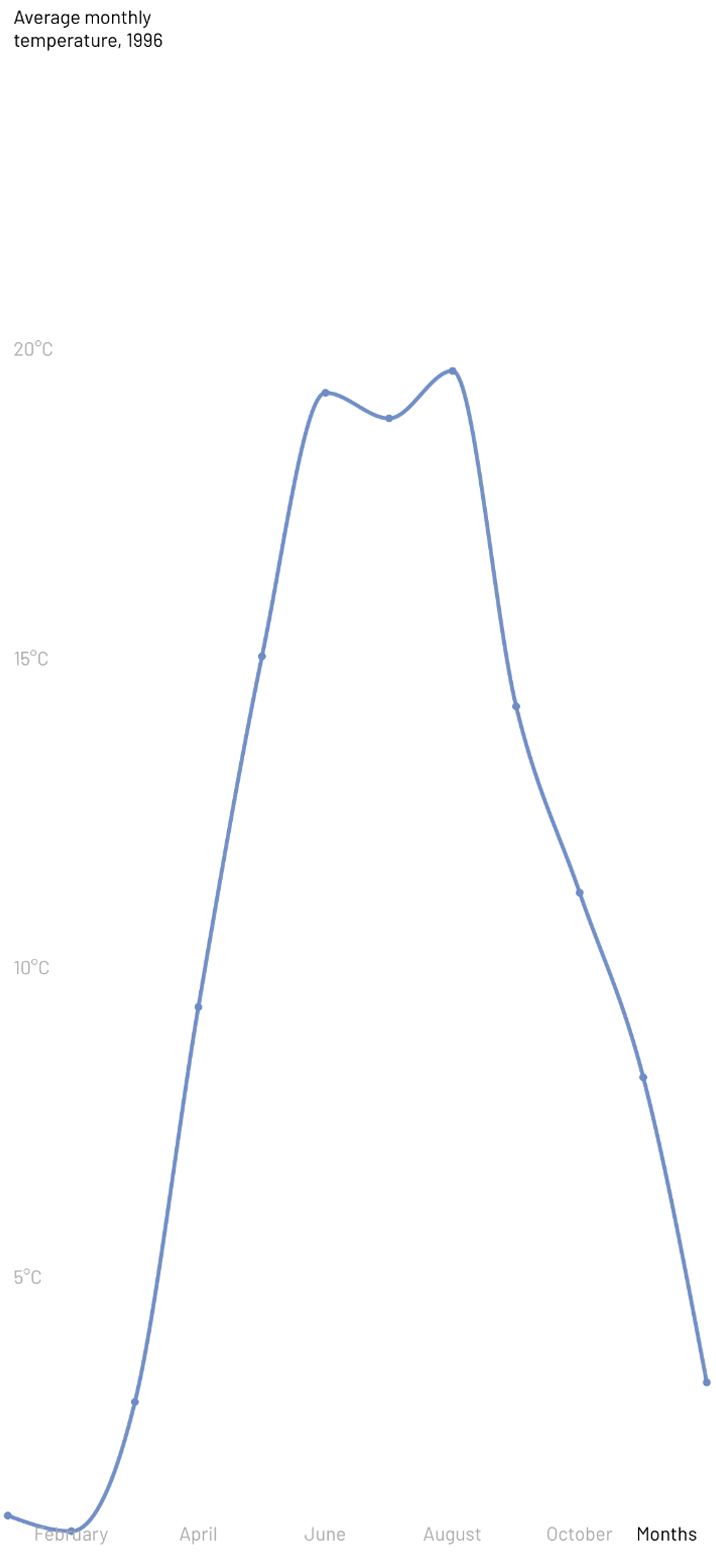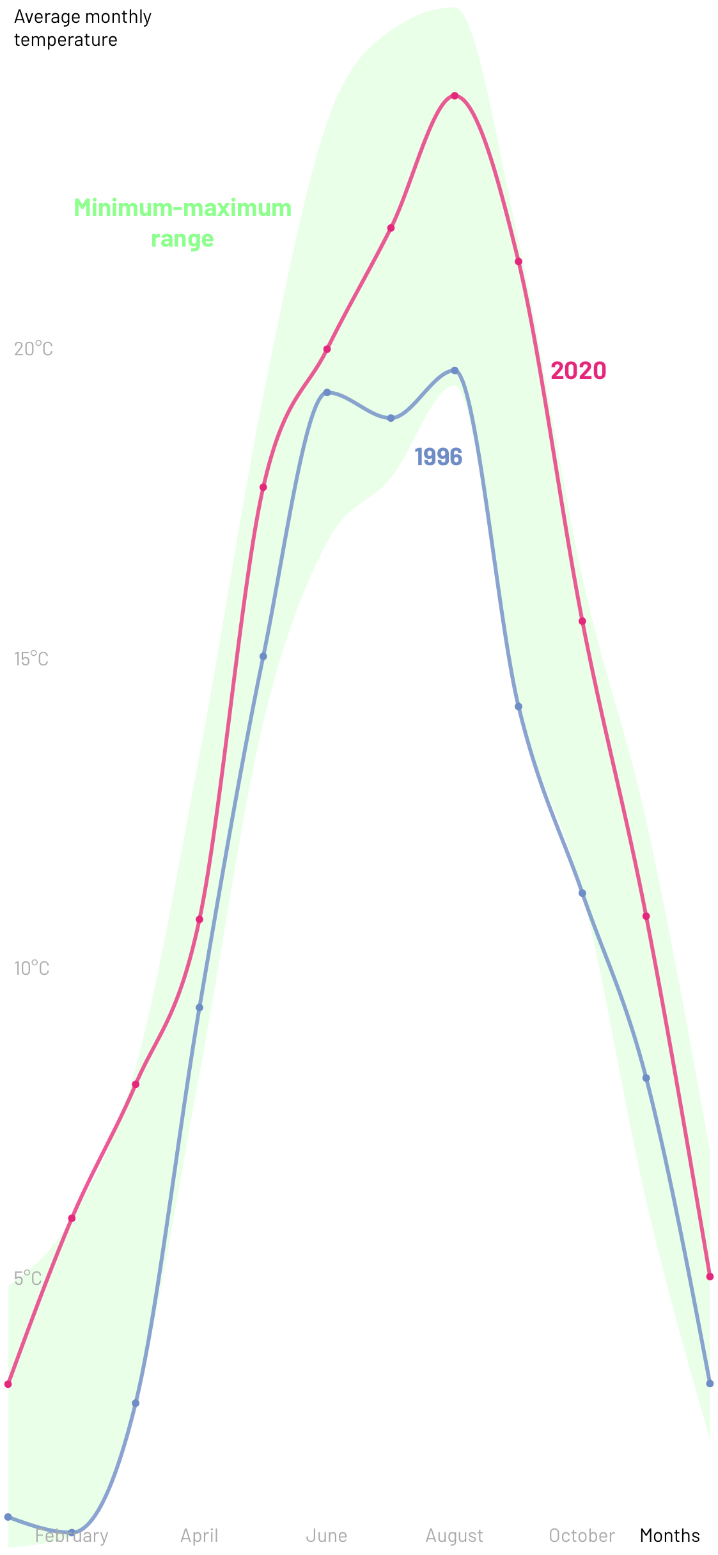DANUBE WARMING UP
Climate change, dead mussels and power plants turned down
Orsolya Fülöp, Attila Bátorfy, Krisztián Szabó
In the nineties, the authors of this article were children, and the Danube was cold. Even on scorching summer days, we’d wade into the water only knee-deep.
On 23 July 1996, the Danube in Hungary was 18-19°C. On 23 July 2022, it exceeded 26°C.
In recent years, we have been having fun swimming in the Danube, but warming temperatures and increasingly frequent and extreme low-water periods are posing a growing challenge for the Danube's wildlife and for its users, for mankind.
Taking all international water station’s data together, the average annual temperature of the Danube was 10.4°C in 1996 and 14.2°C in 2020.
There have been hot months in other years too, but overall the upward trend has been steady over the past decades.
The Danube is Europe’s second longest river after the Volga in Russia. It is formed by the confluence of the Berg and Brigach streams at Donaueschingen in Germany, and flows a total of 2,857 kilometres to the Black Sea.
From the late 18th century, industrialization started to seize the Danube basin, which dramatically accelerated after World War II. Even though more than half of the river is classified as “heavily modified” today, it is still the most species-rich European river system when it comes to native fish species, with a total of 102 native species, 55 of which are in the river’s Hungarian section. About 25 native species are flagged as endangered on the International Union for Conservation of Nature's Red List of Threatened Species.
The Danube flows through ten countries: Germany, Austria, Slovakia, Hungary, Croatia, Serbia, Bulgaria, Romania, Moldova and Ukraine.
Danube drains the most international river basin on earth, shared by 19 countries. Romania has the largest part (29%) of the river basin and the longest river section (1020 kilometres).
The entire territory of Hungary lies within the river's watershed area, with 417 kilometres of the river flowing through the country.
Together with its tributaries, the Danube is one of Europe's most important rivers, both economically and culturally, with nearly 900 municipalities and around 14 million people living on its banks. In four of the ten countries, the Danube flows through the capital: Vienna in Austria, Bratislava in Slovakia, Budapest in Hungary and Belgrade in Serbia.
According to a report by the European Commission's Joint Research Centre, observational records from 1950 onwards and climate projections for the 21st century provide evidence that frequency, duration and intensity of droughts have increased especially in the Mediterranean, but also in western, south-eastern and central Europe.
According to the ICDPR climate change adaption strategy, weather and hydrological extremes (heat waves, droughts, floods) will continue to occur at increasingly extreme levels. Summer rainfall will decrease, especially in the south of Europe – small rivers in the Balkans are expected to dry up within the next 60 years, which will only exacerbate water shortages. In the middle and lower sections of the Danube, longer and more frequent periods of drought and low water flows are expected, especially in the summer and fall.
"Climate change scenarios for the Danube River Basin predict increases of temperature in general by mid and end of this century, which might have adverse impacts on the temperature of rivers" – states the ICPDR.
According to data from the European Forest Fire Information System (EFFIS), there have been more than 250,000 small and large forest and brush fires in the Danube river basin since March 2019. Forest fires, previously affecting in particular Spain, the Balkans or Greece in Europe, caused by dry heat and spreading rapidly towards populated areas, are increasingly likely to appear further north.
Based on temperature measurement data, the Danube is getting warm.
The database of the Trans-National Monitoring Network, managed by the ICDPR contains temperature data for 39 Danube monitoring stations. However, it only contains one data per month and covers a limited period. Besides, the data in several years are incomplete. Nevertheless, we could still use data from 34 stations starting from the year 2010, and visualize warming of the Danube.
Measuring stations in Hungary show an annual average temperature increase of 0.7 to 2.2 C° between 2010 and 2020, while in Austria water temperatures increased by 0.7 to 1.8 C° in the same period.
ICDPR data shows that the highest warming, more than 3°C, was recorded at Sulina in the Danube Delta (Romania). In Hungary, the highest warming of 2.2 C° was measured at Hercegszántó, at the Serbian border.
For some locations, we have longer time series as well.
Based on these, in 1965, the average annual temperature of the Danube ranged between 8.5 and 11.5°C, moving from north to south. Fifty years later, in 2015, the average temperature of the river was between 11.4 and 14.2°C.
The summary graph shows that everywhere from Kienstock in Germany to Bratislava and Novo Selo in Bulgaria has experienced warming over the decades.
What causes the warming?
András Abonyi, a researcher at the Institute of Aquatic Ecology of the HUN-REN (formerly MTA) Institute of Ecological Research, told us that research shows that the rising Danube water temperature is mainly (about 80%) caused by the global increase in air temperatures.
According to Abonyi, the warming of the Danube is a problem in itself, nevertheless, it needs to be interpreted in the context of other factors, like seasonal shifts, such as early spring warming, and the increased frequency of extreme conditions like low-water periods.
Although the total water flow of the Danube has not changed, said Abonyi, but its distribution and the course of the floods have shifted. In the cold-water periods, the Danube has a surplus of water, while it suffers a shortage in the warm-water periods.
Many use the water of the Danube and its tributaries for many different purposes. Conventional gas and nuclear power plants are among the first to mention, requiring enormous amounts of water to generate electricity. According to a study by the Joint Research Center, 44% of the river water used in the Danube region is consumed by the energy sector, 26% by agriculture, 17% by industry and 13% by households.
In Hungary, the water of the Danube is used by the Paks Nuclear Power Plant, Csepel II, Gönyű, Kelenföld, and Százhalombatta plants for cooling.
The Paks plant, for example, draws 100 cubic metres of water per second from the Danube, which means 8,640,000 cubic metres of water per day. This would fill roughly 3456 olympic swimming pools every single day.
Not only does the power plant take water out, but it also pours the same amount of water back in, only heated to 30-35°C.
The rising temperature of the Danube presents a serious problem for both the intake and the release of water.
The hotter the water, the less efficiently it can cool a plant – which reduces its output. The hot water spilled back can overheat the river and endangers its ecosystem, particularly in low water periods when the water cools down more slowly.

According to the Paks NPP, they never exceeded the legal temperature limits for hot water release. However in 2018, 2022 and 2023, Atlatszo has recorded water temperatures above 30°C at the measuring point just further down the plant, even though the plant was operating at reduced capacity.
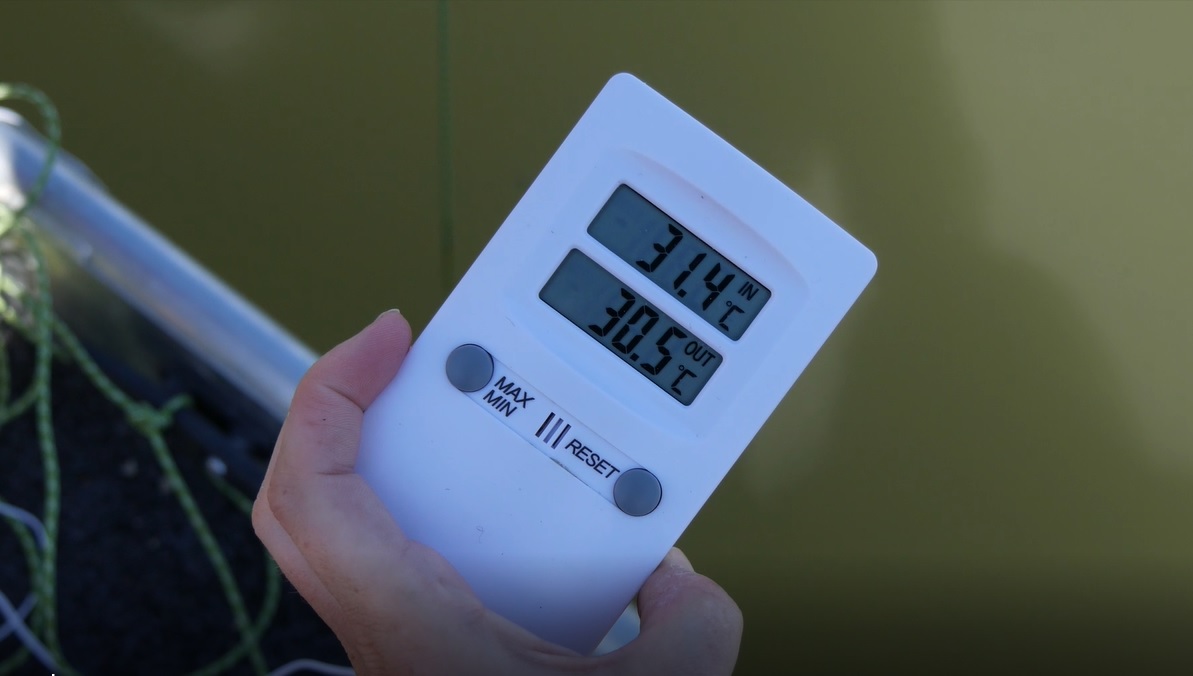
Low water periods present a problem for the intake of the water by the plants, too. In 2018, low Danube levels almost caused the Paks plant go without water. Should this happen, the plant would have to be shut down which could have caused power shortages. And even then, the plant could not stop functioning immediately, which means it would continue needing some amount of cooling water.
Source of image on the map: Report on the extension of the operating life of the Paks nuclear power plant (2004)
According to the Austrian Federal Environment Agency, the annual water demand of industries throughout Austria is 2.2 billion cubic meters, 70 percent of the total demand in the country. 90 percent of the water used by industries is used for cooling, and 60 percent of cooling water demand in Austria is accounted for by metal production and processing. Upper Austria has the most industrial companies in the whole of Austria per federal state, with the locations on the Danube in the steel production, chemicals, mechanical engineering and iron sectors.
One of the oldest and best known is Voestalpine. An average of 60,000 cubic meters of cooling water per hour flows through the pipes for cooling in steel production at the site where the Danube and the mountain river Traun meet. This company is also struggling with an increasingly warm Danube. Just a few years ago, the Danube reached maximum temperatures of 19 to 20 degrees at the site in summer. Now it is already 22 to 23, at least for the last four summers. There are actually strict regulations on how they are allowed to use the cooling water: at 30 degrees Celsius and no higher, the used water is allowed to end up back in the river. This could prove fatal in the future, as there is less of a temperature difference up to the permitted 30 degrees of cooling water. The result is less production capacity during summer days. Voest has already asked the state of Upper Austria several times in recent years for a special rule, and in the last three years, the company was allowed permit for a maximum temperature of 35 degrees for certain summer days. It is assumed that they will submit an application for an exemption this year as well.
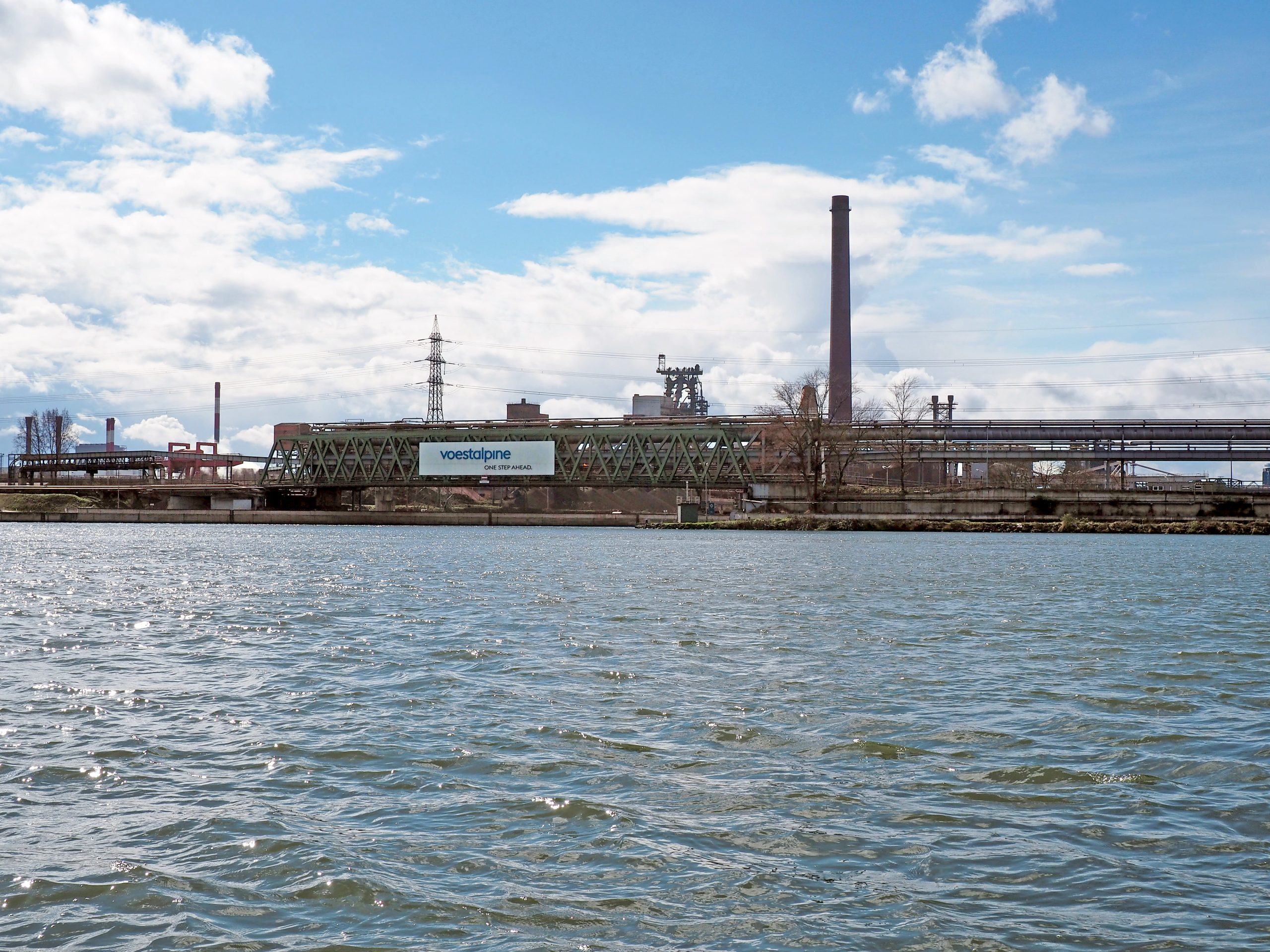
Kurt Eberhardsteiner, Head of the Water Management Department of the City of Linz, says "this can only be a short to medium-term approach, because the Danube is clearly continuing to warm up. On one hand, there is less precipitation in summer and the water flow is tending to decrease. On the other hand, the Traun tributary is also receiving less and less cold water from the Alpine glaciers.” One solution would be the so-called cooling towers, however, says Eberhardsteiner, they can cost several million euros more than a normal cooling water flow.
Droughts and low water levels can decrease electricity generation potential of hydropower plants as well, as their operation depends on water volumes. The Danube and its tributaries have thousands of hydropower plants of all sizes.
On the Austrian section of the Danube, a dozen of large hydropower plants of more than 100 MW are located directly on the water, as are many of the country’s 2,500 small to medium-sized hydropower plants as well.
The Iron Gate I and II plants, operated jointly by Romania and Serbia, are the largest hydropower plants on the Danube with 2,532 MW capacity, and among the largest in Europe. Hungary, being a flat country, only has a couple of very small hydropower plants. The Gabcikovo hydropower plant (720 MW) in Slovakia the second largest hydropower and dam system on the Danube, is the closest to Hungary.

Ecological impact
As researcher András Abonyi explained, their studies did not cover the effects of industrial facilities, but "the warming of the Danube water temperature generally affects the amount, composition and size of floating organisms (e.g. algae). This ultimately affects the functioning of the entire Danube food web. This may also have positive effects, e.g. it may have contributed to the explosive return of the Ephoron virgo, a large potamal mayfly." “Direct cooling water discharges have mainly localised effects, with overall effects on the whole river ecosystem being negligible compared to the effects of air temperature and water flows," he said.
Still, impacts of cooling water discharges by the industrial plants is tangible at the local level. According to the environmental impact assessment of the lifetime extension of the Paks Nuclear Power plant stated that hot water does not impact fish significantly, but it is significant for macroscopic invertebrates. Besides, under warmer water conditions, newly introduced, invasive species can rapidly reproduce and outcompete native species. In addition, they say, high algal blooms caused by prolonged low water conditions and warm water temperatures can also lead to fish mortality as fish drown due to the lack of oxygen caused by the algae.
Researchers noticed dead snail and mussel shells and stinky sludge at the warm water canal first in 2002, and they attributed it to the hot water release. These phenomena were also captured by Atlatszo, whose crew also observed a yellowish, stinky foam on the surface of the water.
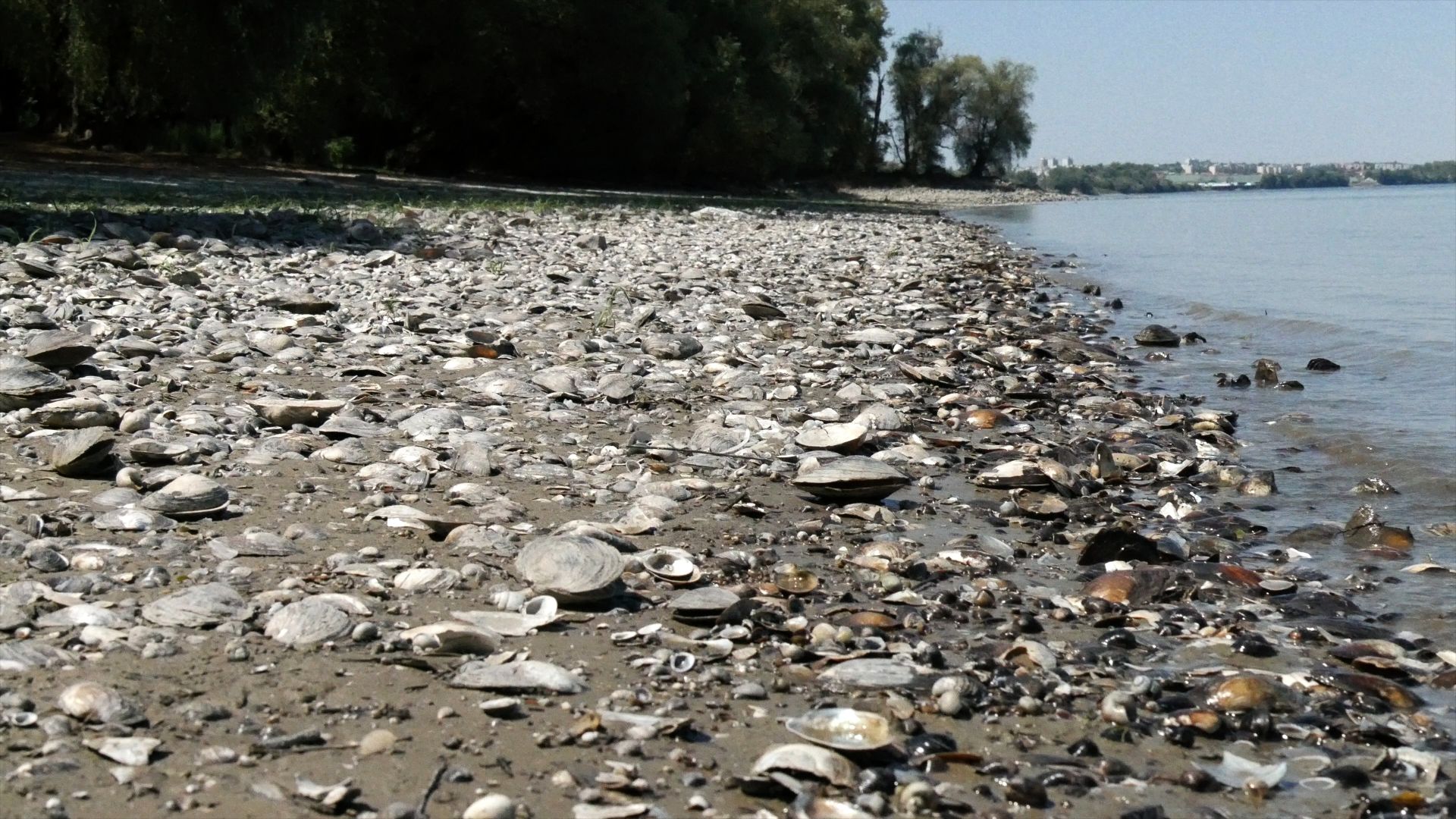
Regulation
The European Union’s Water Framework Directive aims to achieve and maintain healthy rivers and lakes. The overall aim is to achieve a good chemical and ecological status for surface waters. Surface waters, to be healthy, require that their communities and chemical makeup are mainly unaffected by human activity. The Directive leaves it up to Member States to decide how to best meet these requirements and does not set out a specific EU standard for water temperatures.
In Hungary, temperature limits only exist for nuclear power plants. The relevant regulation requires that
- the difference in the temperature of the discharge water and the receiving water must not exceed 11 °C, or 14 °C if the receiving water temperature is below +4 °C,
- and that the receiving water temperature shall not exceed 30 °C at any point within 500 meter downstream of the point of discharge.
In Austria, the Danube’s temperature is being measured by regional authorities, the same counts for restrictions for putting cooling water back into the river. For example, in the case of the Donaukanal, an arm of the Danube that flows through Vienna, temperature levels have to be below 26 degrees in 95 percent of measurements. In 98 percent of measurements, its temperature cannot be higher than 27 degrees. In general, the Austrian law puts a cap on the temperature of water that is emitted into rivers at 30 degrees. According to the Austrian Environmental Protection Agency, the warming of the Danube has so far not been a major problem in Austria because the river is still a mountain river and relatively cool in this stretch.
Methodology
The Danube database downloaded from the ICDPR website contained temperature data from 39 stations along the entire Danube between 1996 and 2020.Between 1996 and 2010, the data were partial for some stations and there were some uninterpretable measurements. From 2010 onwards, the database included regular, at least monthly, validated data reporting for the stations, calculated as monthly and annual averages for some figures. Several stations were located on both sides of the Danube border, so the data from these paired stations were averaged. The graphs and maps thus show data from 34 stations.
Data used
- Population: Eurostat GISCO Local Adminsitrative Units 2021
- Soil Moisture Index Anomaly: European Drought Observatory
- Power plants: The Joint Research Centre Powerplant Database, Hidalgo Golzales et. at. EC 2019
- Danube watershed: HydroSheds
- Forest fires: European Forest Fire Information System (EFFIS)
- Trans-National Monitoring Network
- Danube River Basin Management Plan, International Commission for the Protection of the Danube River, 2021
- MVM Paks Nuclear Power Plant Ltd. Implementation of a monitoring programme for the characterisation of the ecological status of the Danube, Annual Monitoring Report 2021, 2022, Kék Csermely Kft.
- Data provided by the Central Transdanubian Water Directorate
- Data provided by the National Water Directorate General
Bibliography
- Schmid, M.; Haidvogl, G.; Friedrich, T.; Funk, A.; Schmalfuss, L.; Schmidt-Kloiber, A.; Hein, T. (2023): The Danube: On the Environmental History, Present, and Future of a Great European River. In: Wantzen, K.M. (ed.): River Culture – Life as a Dance to the Rhythm of the Waters. Pp. 637–671. UNESCO Publishing, Paris. DOI: 10.54677/INTF8577
- Integrating and editing new scientific results in climate change research and the resulting impacts on water availability to revise the existing adaptation strategies in the Danube River basin”, Danube River Basin Climate Change Adaptation, German Federal Ministry for the Environment, Nature Conservation and Nuclear Safety, 2018
- Meteorological Droughts in Europe, Events and Impacts, Past Trends and Future Projections, Joint Research Centre, 2016
- Water scenarios for the Danube River Basin: future challenges and preparedness, Joint Research Centre, 2020
- Danube River Basin Management Plan, International Commission for the Protection of the Danube River, 2021
Created by:
Orsolya Fülöp, Attila Bátorfy, Krisztián Szabó
Contributions from der Standard:
Melanie Raidl, Alicia Prager, Robin Kohrs



This article was supported by Journalismfund Europe.

2024
